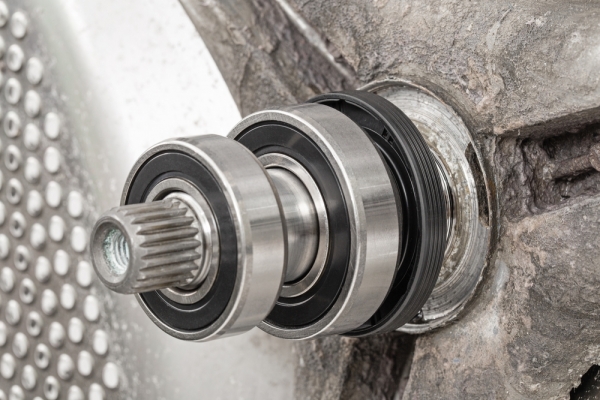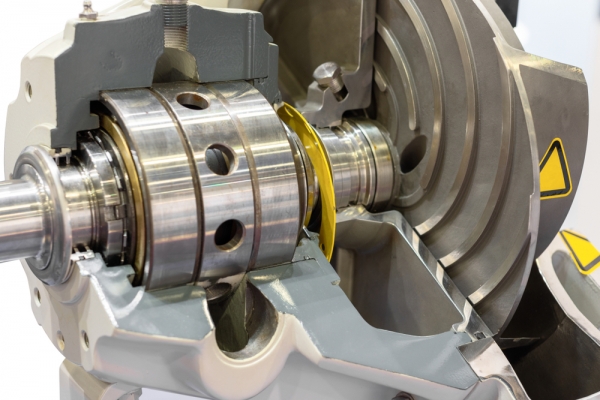-
Homepage
-
Seals and Gaskets
-
Standard Profiles
-
Shaft seal
- Axial Shaft Seal Ring
When dirt enters the area of the axial shaft, it can damage the lubricant, encourage corrosion, and cause premature damage to the bearing. Axial shaft seals offer a solution to prevent this. These seals are designed to endure applications where they are exposed to heavy contaminants.
There are various types of axial shaft seals, such as V-ring seals, metal-encapsulated V-seals, clampable axial seals, and mechanical seals.
Seals like axial shaft seals have become essential in seal technology, especially within the field of drive technology.
Contrary to radial shaft seals, which mainly function to seal the axis in the radial direction, axial shaft seals operate in the axial direction and provide effective sealing against axial forces.
An example of a radial shaft seal application is a rapidly spinning shaft that extends out from a gearbox or engine. However, no dirt or fluids should enter the gearbox or engine housing.
An application instance for an axial shaft seal or axial shaft seals is a pneumatic, electric, or hydraulically driven drawbar or piston moving back and forth in the axial direction. Similarly, the axially moving piston or push rod should not carry any contaminants, gases, or liquids into the housing. The axial shaft seal is specifically designed for this purpose.
Functions of Axial Shaft Seals
Axial shaft seals are used to prevent the escape of liquids or gases from a housing containing a rotating shaft. They are designed to provide a seal between the shaft and the housing while being able to transmit axial forces. They are often used in various machines and applications, such as pumps, motors, transmissions, valves and compressors.
The axial shaft seal consists of a plastic or metal housing and a flexible sealing element that is adapted to the shaft or fits snugly on the rotating shaft. The sealing element may be made of various sealing materials. Here, the material clearly depends on the requirement and use as well as the size or the outer diameter of the shaft.
As the shaft rotates, the seal member of the axial shaft seal ring is pressed against and seals the shaft to prevent leakage of liquids or gases. It is also the task of the shaft seal to prevent the penetration of dirt or unwanted liquids or air.
In addition to sealing, the axial shaft seal ring must also be able to transmit axial forces caused by the rotation of the shaft. These forces may affect the seal or damage the housing if not properly absorbed. The axial shaft seal is designed to absorb these forces while ensuring a reliable seal.
Structure and components of an axial shaft seal
An axial shaft seal comprises several components that collaborate to prevent the escape of liquids or gases from a rotating shaft. The key components include:
Sealing Lip:
The sealing lip is the core sealing element of the axial shaft seal. Typically made from elastic materials such as nitrile, fluororubber, or polyurethane, it closely fits against the rotating shaft to block the leakage of liquids or gases.
Spring:
A spring is essential for exercising a consistent force on the sealing lip, ensuring it remains in tight contact with the rotating shaft. It can be crafted from various materials, including stainless steel or Inconel, and is commonly implemented as a spiral spring.
Housing:
The housing of the axial shaft seal, constructed from metal or plastic, aims to protect the sealing lip and to stabilize the entire unit. Typically cylindrical in design, it is available in a range of sizes and configurations to suit different applications.
Beyond these core components, axial shaft seals may also incorporate additional elements like dust protection lips, lock rings, or extra springs to guarantee a perfect seal. Frequently, they are combined with O-rings and wipers in pneumatic or hydraulic systems to ensure the utmost tightness and cleanliness of the shaft's running surface.
Types of Axial Shaft Seals
There are various types and styles of axial shaft seals designed to suit specific applications and machine constructions. Below are some of the most common types:
Rubber Sleeve Shaft Seals:
These shaft seals consist of a flexible rubber sleeve that conforms to the shaft. They feature a simple design and are employed across a wide range of applications.
Double Twist Shaft Seals:
Characterized by two elastic lips twisted in opposite directions, these shaft seals enhance the sealing effect and perform better at higher speeds.
Metal Shaft Seals:
Comprising a metal housing with a flexible sealing element that adapts to the shaft, these seals are especially suitable for applications involving high temperatures and aggressive substances.
Labyrinth Shaft Seals:
This seal type uses a series of interlocking rings to create a labyrinth channel, effectively slowing the ingress of liquids or gases into the housing and thereby improving the seal.
Cassette Seals:
A cassette seal is a specialized form of radial shaft seal, consisting of a metal housing (cassette) and a sealing element, typically made from an elastomer or PTFE. The housing acts as a support for the sealing ring that encloses the shaft needing sealing. Cassette seals are generally used for their enhanced sealing reliability and longevity compared to traditional radial shaft seals, making them ideal for applications with stringent tightness requirements, such as in the chemical industry or in high-pressure fluid or gas transfer.
Combined Shaft Seals:
These seals merge different sealing mechanisms to achieve superior sealing efficiency. For example, combining a rubber sleeve shaft seal with a labyrinth shaft seal can enhance overall sealing capabilities.
V-Ring Seals:
Specifically designed for high temperature, chemical resistance, and high wear applications, V-ring seals are made from an elastic material like fluororubber (FKM), featuring a distinctive V-shaped cross-section. This design allows for a larger sealing surface on the shaft, enhancing both the seal and its wear resistance. Furthermore, V-ring seals are generally easier to install than other shaft seal types due to their reduced shaft pressure and associated friction. V-ring seals find applications in numerous industries, including pumps, compressors, gearboxes, motors, and more, and are particularly beneficial in the chemical, food and beverage, and aerospace sectors due to their robust performance in harsh environments.
Selecting the appropriate type and style of axial shaft seal is crucial for the application to ensure efficient sealing and durability.
Applications of Axial Shaft Seals
Axial shaft seals are utilized in a broad range of applications to ensure a dependable seal for rotating or oscillating shafts. Common applications include:
Industrial Machinery:
Axial shaft seals are deployed in various types of industrial machinery, including pumps, compressors, gearboxes, and motors.
Automotive Applications:
Axial shaft seals are employed in automotive engines to prevent the leakage of oil or other fluids.
Aerospace:
Axial shaft seals are applied in aircraft and rocket engines to prevent the escape of fuel or lubricants from the system.
Food and Beverage Industry:
Axial shaft seals are used in processing facilities for food and beverages to maintain a hygienic environment and to prevent contamination.
Marine Applications:
Axial shaft seals are used in ship engines and gearboxes to prevent the ingress of saltwater, thereby avoiding corrosion.
The application spectrum for axial shaft seals is extensive, making it crucial to choose the correct type and model of seal for each specific application to ensure a reliable seal and extended lifespan.
At Kofler - Dichtungen, we are eager to assist you. Please inform us about your application, intended use, and required dimensions!
Commonly Used Materials for Axial Shaft Seals
Axial shaft seals can be made from a variety of materials suitable for their applications. Here are some common materials for shaft seals:
- NBR (nitrile-butadiene rubber): a common material for rotary seals that is well resistant to mineral oils and lubricants
- FKM / FPM / Viton (fluorosilicone rubber): a high-temperature resistant material that is also resistant to aggressive media such as fuels, oils, and chemicals
- EPDM (ethylene-propylene-diene rubber): a material with good resistance to water, steam, and cold (high and low temperature range)
- PTFE (polytetrafluoroethylene): a material with excellent sealing properties and chemical resistance, but less flexibility than other materials
- Graphite Reinforced Rubber: a material that combines rubber with graphite fibers to provide better sealing and wear resistance.
The choice of the right sealing material depends on various factors, such as the requirements for the seal (e.g., chemical resistance, temperature resistance), the operating conditions (e.g., speed, pressure), and the media used (e.g., lubricants, liquids). Furthermore, you will of course also receive various hydraulic seals and pneumatic seals from us!
We at Kofler - Dichtungen are happy to advise you - material, design, variants and dimensions as well as assembly - Request your personal advice. Because under pressure we are the best!
Axial Shaft Seals and Environmental Protection
Axial shaft seals can also significantly contribute to environmental protection, particularly in applications requiring the sealing of aggressive or hazardous media. By providing a reliable seal, they can prevent potential leaks and breakdowns, leading to diminished environmental impacts.
In industries such as oil and gas, axial shaft seals can be deployed to avert the entry of oil or other fluids into the environment. Within the food and beverage sector, these seals can enhance hygiene standards and lessen the risk of contamination.
Moreover, certain manufacturers of axial shaft seals may adopt eco-friendlier materials and manufacturing techniques to lessen their environmental footprint. For instance, utilizing recycled materials or converting to renewable energy sources for production can be effective strategies.
Overall, axial shaft seals play a vital role in mitigating environmental pollution by preventing leaks and failures and by embracing greener materials and production methodologies.
What should be considered when buying an axial shaft seal?
When purchasing an axial shaft seal, several factors should be considered to ensure that the seal is suitable for the application, including:
- Speed: The axial shaft seal must be designed for the maximum speed achieved in the application. If the rotational speed is too high or the circumferential speed is too high, the sealing ring may be damaged and its effectiveness may be reduced.
- Outer diameter: The outer diameter of the sealing ring should be compatible with the housing of the application in which it will be installed. If the diameter is too large, the sealing ring will not fit and if it is too small, it will not be able to seal properly.
- Inner diameter: The inner diameter of the sealing ring should be compatible with the shaft on which it will be installed. If the diameter is too small, the sealing ring will not fit and if it is too large, it will not be able to seal properly.
- Design: How must the axial seal be constructed, does it need a sealing lip or dust lip, which design does justice to the situation to be sealed?
- Pressure: How much pressure must axial shaft seal withstand? Is it installed in a compressor or is it part of a hydraulic system?
- Field of application: pneumatics, hydraulics, special functions, or special materials are in demand.
Therefore, when selecting an axial shaft seal, it is important to consider all of these factors to ensure that the seal meets the correct specifications for the application.
Conclusion
Axial shaft seals are used to prevent the leakage of liquids or gases from machines with rotating shafts. These seals consist of a sealing lip, a spring, and a housing. The sealing lip is typically made from nitrile, fluorocarbon rubber, or polyurethane, and must be selected carefully based on the application's temperature and chemical resistance requirements.
The spring is essential for exerting a uniform force on the sealing lip, ensuring it maintains close contact with the rotating shaft. The housing, which can be fabricated from metal or plastic, serves to protect the sealing lip and secure the entire unit.
Selecting the right axial shaft seal involves considering several factors. These include the shaft's rotational speed, the pressure of the medium being sealed, the application's temperature, the chemical resistance of the materials, and the design and size of the housing.
A meticulous evaluation of these factors, followed by an appropriate selection of the materials and dimensions for the axial shaft seal, is vital for achieving effective sealing and extended machine service life.
At Kofler - Dichtungen, we're eager to assist you with choosing the suitable material, design, variants, and dimensions, as well as with the assembly process. Request our expert consultation now. Because under pressure, we excel!
FAQs on Axial Shaft Seals
What types of shaft seals are there?
There are different types of shaft seals, including radial and axial shaft seals. Radial shaft seals are used to prevent leakage of liquids or gases from the lateral movement of a rotating shaft. Axial shaft seals, on the other hand, are used to prevent the escape of liquids or gases from the axial movement of a rotating shaft.
What does a radial shaft seal do?
A radial shaft seal prevents the escape of liquids or gases from the lateral movement of a rotating shaft.
What does an axial shaft seal do?
An axial shaft seal prevents the escape of liquids or gases from the axial movement of a rotating shaft.
What are common materials for axial shaft seals?
Choosing the right material for an axial shaft seal depends on various factors such as the application temperature, the chemical properties of the sealed medium and the required strength. Common materials for axial shaft seals are nitrile, fluororubber and polyurethane. Nitrile is a commonly used material due to its excellent resistance to oils and fuels as well as its high abrasion resistance.
Fluororubber is popular due to its high resistance to chemicals and high temperatures. Polyurethane offers high abrasion resistance and is particularly suitable for applications with high speeds or pressures. Depending on the requirements, other materials such as PTFE, silicone or EPDM can also be used.





